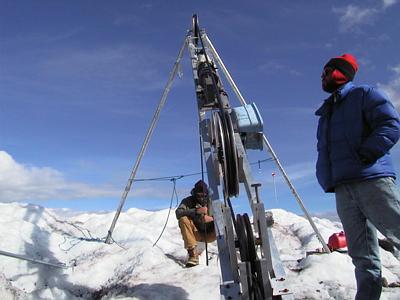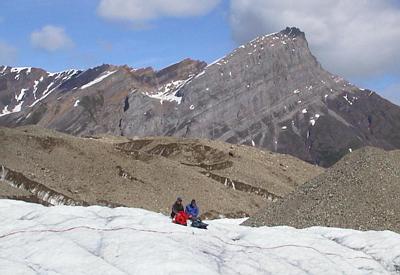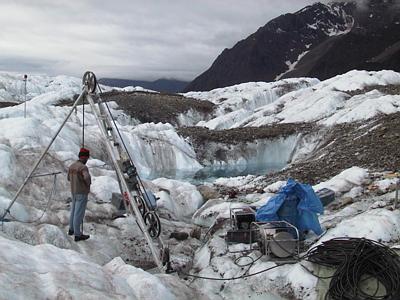
|
|
11 July, 2000
July 11, 2000
Work commenced at our new drill site today. The ice is significantly cleaner
at this location than at the former site, and as a result, the hot water
drill melted through the ice at about 2-3 times the pace. The drilling did
not slow until we got to about 180 meters. At the other site, debris was
obstructing the bottom of the hole by 50 meters down.
St. Olaf undergraduate Andrew Malm continued doing ice radar. His equipment
has been out of commission for the past 3 days - his oscilloscope was
malfunctioning. He managed to fix the problem. He plays an important role
because he determines the thickness of the ice where we are drilling (as well
as other spots). Ice radar works on a very simple principle. A transmitter
sends out a pulse of electromagnetic radiation at a parcticular frequency,
which is determined by the length of the transmitting antenna. This pulse
emanates in all directions from the transmitting antenna, including down and
into the glacier. This pulse also reflects off of surfaces. The most
significant and obvious reflecting surface is the bedrock upon which the
glacier rests. The electromagnetic wave travels downward through the ice,
reflects off of the bed, and is received by a receiving antenna. Andrew
interprets this return signal on an oscilloscope. Based on the time of
travel, and knowing the speed of the signal, Andrew is able to determine the
distance that the wave traveled. Andrew was determining a thickness of about
250 meters at our former site. At our new site, he determined an ice
thickness of 1200 meters. This is pretty thick. In fact, we only have 800
meters of hose to drill with, so if the 1200 meter thickness is correct, than
we will not likely drill to the glacier bed at this spot. Andrew Malm does
not think that this measurement is correct. He is going to do some more
radar shots tomorrow.

Once drilling, the work can be slow and tedious. PSU grad student Don Lindsay sits at the hole, monitoring the progress of the advancing drill. PI Andrew Fountain is staring into the distance, enjoying the view.

St. Olaf undergraduate student Andrew Malm and PSU graduate student Andrew Malm discuss the results of the ice radar work on the Kennicott Glacier.

PSU glaciologist and Principal Investigator Andrew Fountain stands ready at the drill. The water is pumped from the pool in the background. The heating plant, pump, and hose are in the lower right. The drill tower feeds hose into the advancing borehole.

PSU graduate student Michelle Cunico plays out ice radar antenna on the Kennicott Glacier near the new drill site.

Contact the TEA in the field at
.
If you cannot connect through your browser, copy the
TEA's e-mail address in the "To:" line of
your favorite e-mail package.
|
